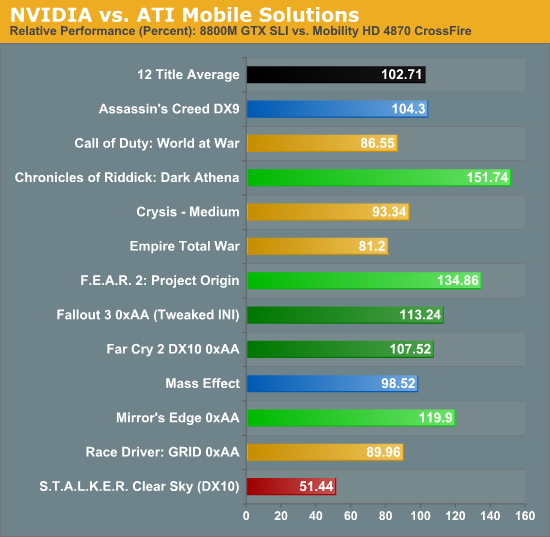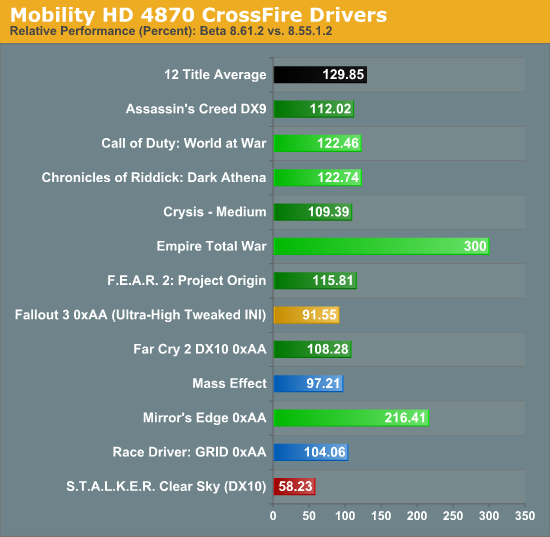ASUS W90Vp: ATI Mobility Radeon HD 4870... with CrossFire
by Jarred Walton on May 29, 2009 5:00 AM EST- Posted in
- Laptops
HD Gaming Comparison
We'll start out with a comparison of performance at 1920x1080 in order to focus squarely on the intended use of these notebooks. We will have performance results at 1680x1050 later, as well as detailed results on the next page. The easiest way to look at things is to look at the relative performance in terms of percentages. We have several charts that break things down, starting with the comparison of NVIDIA's 8800M GTX SLI and ATI's Mobility Radeon HD 4870 CrossFire.

If we look at average performance, this is actually a very close match up. We suspect that with a faster dual-core processor, the ATI solution would take the lead as we are CPU limited in many of these titles. However, there are definitely games where NVIDIA excels and other titles where ATI holds a clear lead. The Chronicles of Riddick: Dark Athena, FEAR 2: Project Origin, and Mirror's Edge all clearly favor NVIDIA -- and that's not even taking PhysX support in Mirror's Edge into account. On the other hand, Call of Duty: World at War, Empire: Total War, STALKER: Clear Sky, and to a lesser extent Race Driver: GRID and Crysis (at medium detail) all favor the ATI solution. It's worth noting that this is the best-case scenario for ATI, since we are using the optimal driver configuration with the beta ATI driver. Let's see what the beta driver does for performance relative to the original driver.

Obviously, the newer titles stand to benefit most from the updated driver. Despite not being as recent as some of the other titles are, Mirror's Edge sees the biggest performance boost, indicating CrossFire support is now present in the beta driver. Empire: Total War illustrates another important point. We capped the "percent improvement" at 300%, but the reality is that the game was unplayable with the earlier driver. CrossFire mode -- which can't be disabled on the ASUS W90Vp -- causes severe rendering errors, so that most of the objects in the game are not visible. The newer driver fixes the situation, but we are left to wonder how many other games might suffer from similar incompatibilities. A couple games also see small performance drops (Fallout 3 and Mass Effect), and STALKER: Clear Sky performance is cut nearly in half. Many of the remaining titles show improvements on the order of 10% to 20%.
Before we continue, we must again point out that NVIDIA is severely handicapped in this comparison since we are using the bleeding edge, brand-new ATI Mobility Radeon 4870 CrossFire and comparing it to GeForce 8800M GTX SLI, which is over a year old. The 9800M GTX has 112 SPs, potentially improving performance by 17%, while the GTX 260M and 280M increase the gap even more. The GTX 280M has 128 SPs running at 585/1463MHz core/shader, compared to 96 SPs at 500/1250MHz. Core and performance are therefore up to 56% higher, with almost 19% more memory bandwidth. We will be providing our best apples-to-apples comparison between the Mobility 4870 CrossFire and GTX 280M SLI in the near future. ATI currently trades blows with the 8800M GTX, depending on the title, but the driver situation still greatly concerns us. Let's investigate a little more to show why.










25 Comments
View All Comments
nubie - Friday, May 29, 2009 - link
Well. . .If there was a PCI-e standard for mobile, then maybe you could choose your graphics and the laptops would have to work properly with standard drivers?
What if you used DisplayPort for the interface to the display? Then you could plug in any graphics chip and it would work with the standard drivers.
You would of course need "thermal" stages, where you had a cap on the amount of power that it could dissipate, but if you wanted to set your PC on a fan and cut out a vent you could move up.
I think that a standard needs to be set already. There is no excuse for making a handful of extra or different pins, or form factors off by a few millimeters just so that you can't build your own system or upgrade it.
I would hope that as time progresses you could put a faster chip on a smaller more advanced process into an older laptop, or just choose the exact graphics you want (IE less powerful) in a system with the processing power you need.
JarredWalton - Friday, May 29, 2009 - link
Unfortunately, the biggest reason for a lack of unified mobile GPU standards is that OEMs along with ATI and NVIDIA like to compete in a variety of ways. Look at Apple and imagine trying to tell them they their laptops need to conform to a standard layout.It *could* happen, and for higher performance laptops with discrete GPUs like the W90Vp, that would be ideal. In fact, the GPU modules in the W90 look very similar to the GPU modules from NVIDIA. The problem is, no one wants to do the work to make sure upgraded GPUs would work -- plus you need to worry about having not just a standardized form factor, but standardized heatsinks/fans.
Ultimately, a standardized notebook form factor would probably lose more customers than it would gain. Everyone would complain about the "boring design and aesthetics", and the number of new bugs/problems we'd see would probably skyrocket. But hey, maybe someone will prove me wrong on this and make the idea work....
Goty - Friday, May 29, 2009 - link
Wait, NVIDIA managed to release drivers on all platforms simultaneously ONCE and suddenly they have a unified driver model? I'd have to wait and see if that trend continues down the road, but I'm not holding my breath.There's also the issue that a large number of notebooks simply won't accept the drivers directly from NVIDIA.
JarredWalton - Friday, May 29, 2009 - link
NVIDIA previously had a mobile driver program where they committed to quarterly updates, and they delivered on that three times (though the first wasn't quite "quarterly"). The drivers started out several months behind the desktop releases, and now we have drivers released on all platforms twice (185.81 and then the final 185.85) - though granted they're mostly the same thing.As far as laptops where the NVIDIA drivers won't work, are they in the "unsupported" list? They've worked on every laptop I've tried, which ranged from 8600M to 9500M to 8800M SLI to 9800M. What laptops specifically don't work or have problems? Or are these problems caused by old and cluttered Windows installs where malware or something else gets in the way?
If NVIDIA doesn't continue to release unified drivers, we'll certainly point it out, but at the same time they've already strongly committed to minimum quarterly updates. That's more than anyone else has done for mobile graphics.
rbfowler9lfc - Friday, May 29, 2009 - link
Really impressive battery life. You can watch a 1080p movie on the road, as long as it doesn't last longer than 1h. Bah!